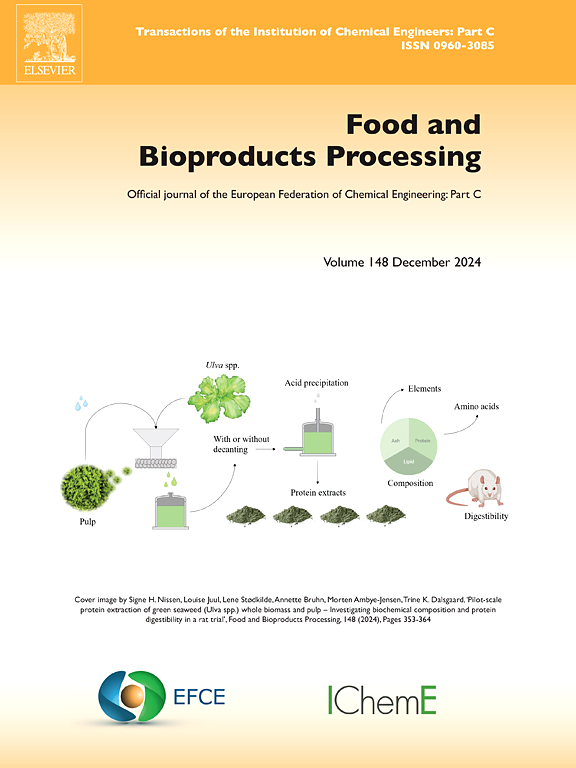The use of a microhydrodynamic model, kinetic analysis and optimization tools for the development of corn starch nanosuspensions via wet-stirred media milling
IF 3.5
2区 农林科学
Q2 BIOTECHNOLOGY & APPLIED MICROBIOLOGY
引用次数: 0
Abstract
Starch micro and nanoparticles have emerged as popular stabilizers in food and pharmaceutical formulations. Wet-stirred media milling (WSMM) to develop such particles has not been widely reported, in contrast to chemical hydrolysis. Therefore, this contribution aimed to analyze the effects of: 1) Sodium dodecyl sulfate (SDS) and post-milling operations on the stability of starch nanosuspensions; 2) the bead diameter (db) (0.15, 0.50 mm) and starch concentration (cS) (1, 3.5, 7 % w/v) on the type and stability of nanosuspensions, breakage kinetics and microhydrodynamic parameters; 3) spray-drying of nanosuspensions on the structural changes and redispersion of powders. Stable nanosuspensions with an average size of 161±5 nm could be obtained, from an initial size of 14.08±0.08 μm. The use of SDS as a stabilizer prevented aggregation during milling and allowed the formation of amylose-SDS complexes, supported by DSC and X-ray techniques. The microhydrodynamic analysis showed that increasing cS decreased the compression forces applied to particles. Moreover, the intensity of collisions was improved with a larger db. Spray-dried nanosuspensions formulated with a cS of 7 % (w/v), different SDS concentrations (0, 0.07 and 1 % w/v), and a db of 0.15 mm were analyzed. Submicron particles could only be obtained with 1 % (w/v) of SDS: from 366 to 271 nm after milling and spray-drying, respectively. Under these conditions, the granules were fully fragmented, which was confirmed by X-ray and TEM techniques. These results showed that WSMM could be implemented as a solvent-free methodology to obtain biopolymer-based nanoparticles.
使用微流体力学模型、动力学分析和优化工具,通过湿搅拌介质研磨技术开发玉米淀粉纳米悬浮液
淀粉微粒和纳米粒子已成为食品和药品配方中常用的稳定剂。与化学水解法相比,用湿搅拌介质研磨法(WSMM)来制备此类颗粒的报道还不多。因此,本文旨在分析以下因素的影响:1)十二烷基硫酸钠(SDS)和研磨后操作对淀粉纳米悬浮液稳定性的影响;2)微珠直径(db)(0.15、0.50 毫米)和淀粉浓度(cS)(1、3.5、7 % w/v)对纳米悬浮液类型和稳定性、破碎动力学和微流体力学参数的影响;3)喷雾干燥纳米悬浮液对粉末结构变化和再分散的影响。结果表明,从初始粒度(14.08±0.08 μm)到平均粒度(161±5 nm)的稳定纳米悬浮液是可行的。使用 SDS 作为稳定剂可防止研磨过程中的聚集,并可形成直链淀粉-SDS 复合物,这一点得到了 DSC 和 X 射线技术的支持。微流体力学分析表明,增加 cS 会降低施加在颗粒上的压缩力。此外,db 越大,碰撞强度越高。对 cS 为 7 %(w/v)、SDS 浓度不同(0、0.07 和 1 % w/v)、db 为 0.15 mm 的喷雾干燥纳米悬浮液进行了分析。只有在 SDS 含量为 1 %(w/v)的情况下才能获得亚微米级的颗粒:研磨和喷雾干燥后的粒径分别为 366 纳米和 271 纳米。在这些条件下,颗粒完全破碎,X 射线和 TEM 技术证实了这一点。这些结果表明,WSMM 可以作为一种无溶剂方法来获得基于生物聚合物的纳米颗粒。
本文章由计算机程序翻译,如有差异,请以英文原文为准。
求助全文
约1分钟内获得全文
求助全文
来源期刊

Food and Bioproducts Processing
工程技术-工程:化工
CiteScore
9.70
自引率
4.30%
发文量
115
审稿时长
24 days
期刊介绍:
Official Journal of the European Federation of Chemical Engineering:
Part C
FBP aims to be the principal international journal for publication of high quality, original papers in the branches of engineering and science dedicated to the safe processing of biological products. It is the only journal to exploit the synergy between biotechnology, bioprocessing and food engineering.
Papers showing how research results can be used in engineering design, and accounts of experimental or theoretical research work bringing new perspectives to established principles, highlighting unsolved problems or indicating directions for future research, are particularly welcome. Contributions that deal with new developments in equipment or processes and that can be given quantitative expression are encouraged. The journal is especially interested in papers that extend the boundaries of food and bioproducts processing.
The journal has a strong emphasis on the interface between engineering and food or bioproducts. Papers that are not likely to be published are those:
• Primarily concerned with food formulation
• That use experimental design techniques to obtain response surfaces but gain little insight from them
• That are empirical and ignore established mechanistic models, e.g., empirical drying curves
• That are primarily concerned about sensory evaluation and colour
• Concern the extraction, encapsulation and/or antioxidant activity of a specific biological material without providing insight that could be applied to a similar but different material,
• Containing only chemical analyses of biological materials.
 求助内容:
求助内容: 应助结果提醒方式:
应助结果提醒方式:


